By far the best Bay Island Bonsai field trip of the year was our visit to the Ancient Bristlecone Pine Forest in California’s White Mountain range. The slow-growing Bristlecone Pines are a marvel – and this is the best place to see them. Along the Methuselah Trail alone, 11 of the 19 known 4,000+ year-old specimens continue to grow, including some of the very oldest (see Anne Johnson’s The Ancient Bristlecone Pine Forest, 1999).
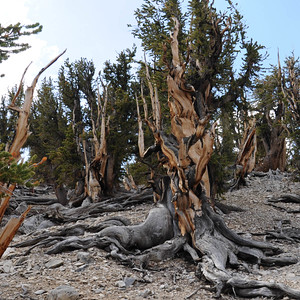
Really old Bristlecone Pine grove.
A combination of factors lead to such long lives, many of which are attributable to the locale. The growing season is short at 10,000 feet – two months give or take – and the weather is harsh. Summers are warm and dry. Overnight freezes mark spring and fall; winter is bitter cold. And unlike the Sierra Nevada range to the west, the White Mountains get relatively little precipitation, 80% of which comes in the form of snow.
It turns out that this is exactly what helps the Bristlecone live as long as they do. While these conditions make it hard for Bristlecone’s to thrive, they make it even harder on any pests or fungus that might give the trees trouble in more hospitable climes. Bristlecone growing in better soil with more precipitation grow larger and more quickly but die much younger.
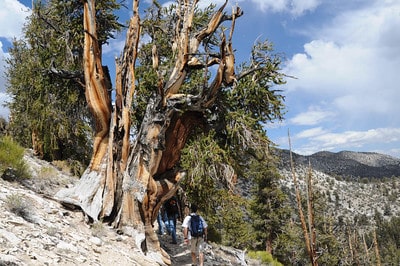
Walking past a large Bristlecone
Many of the older Bristlecone sport dead roots that sit on top of the ground. This is due to erosion. The soil here typically washes down the mountains at a rate of about 1 foot per millenium. Gauging the original soil line is a good way begin estimating the age of a tree. When over a foot of roots are exposed, the tree is likely over 1,000 years old.
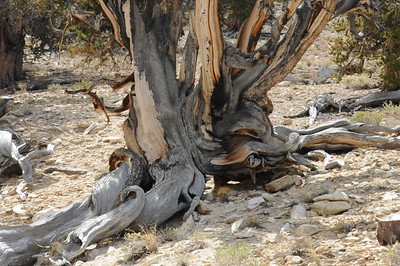
Erosion at the base of a Bristlecone
The Methuselah Trail itself cuts right through the most fascinating groves. Visitors are warned not to veer from the trail to protect the trees. As the soil is mostly loose rock and dust, wandering about can hasten erosion. Fortunately for visitors, there’s plenty to see at almost every turn.
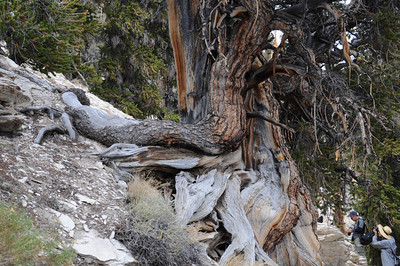
Trompe l’oeil – the tree is big, but not that big. The photographer is shooting a subject behind the pine in the foreground.
Most of the oldest trees grow in a swath of particularly dolomitic soil, identified by the white band in the photo below. This is the Methuselah Grove. In it is the Methuselah tree, a 4,841 year-old specimen, and the world’s oldest known tree.
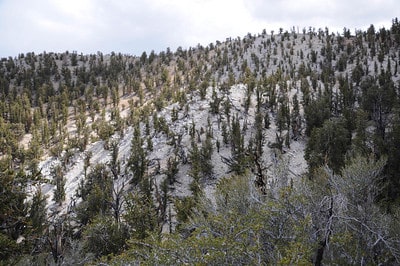
Methuselah Grove
The trees in the Methuselah Grove are smaller than the surrounding trees. Most are odd arrangements of deadwood with occasional younger shoots indicating that a tree is still alive. Several have fallen as erosion claimed the ground beneath the roots yet continue to grow upwards. The tree in the photo below is typical of the area. It is likely between 4,000 and 5,000 years old.
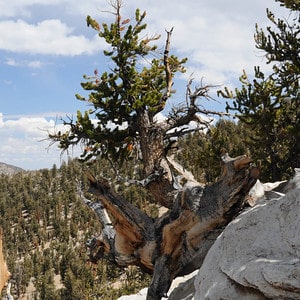
Very old Bristlecone
The Methuselah tree itself is unmarked to prevent unwanted attention. Curiosity rankles many visitors to the area, and the tree’s exact location is the subject of many questions put to on-duty rangers.
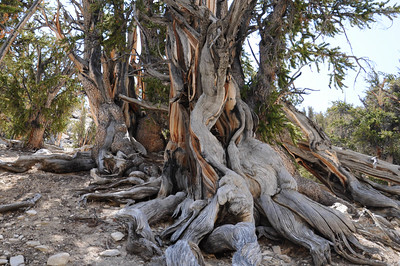
Awesome roots in the Methuselah Grove
After spending a day in the area I became very comfortable with the Methuselah tree’s secret. It’s neat to know how old the trees really are – and fascinating to know down to the year, thanks to dendrochronologists – but a tree’s exact age isn’t apparent to the human eye, and in the big picture, it actually counts for very little. I took as much time as possible to simply study the trees, to see how they grow, to follow the curves of their deadwood and to appreciate their unique characters. I think this is why the area has such appeal to bonsai folk – it’s an outstanding place to see age, character and beauty in nature.
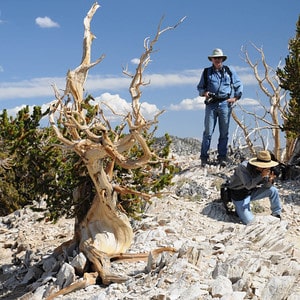
A small Bristlecone
Of course, seeing smaller Bristlecone that exhibited characteristics sought after in bonsai brought big smiles to our faces. Some trees, like the one pictured above and below, received a lot of attention from our group as they were very understandable through our bonsai-tinted lenses.
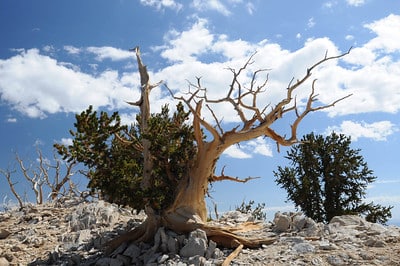
Same tree from the side
This was my second trip to see the Ancient Bristlecone Forest. I think next time I’d like to spend more time in the area and explore the Patriarch Grove, home to the world’s largest Bristlecone Pine. Like a large bonsai exhibit – think Kokufu – it’s both wonderful and a lot to take in for one day.
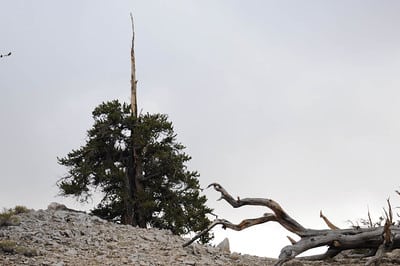
Formal upright Bristlecone with hollowed-out trunk.
Our day ended with rain. It made the view more striking and it brought out the unique desert aroma of sage and sand. Driving down from the mountain we appreciated dramatic rays of light striking the Owens Valley below. The trees above, I am sure, were appreciating the fresh water.
Related posts:
- Ancient bristlecone pine forest – highlights from the bristlecone pine forest
- Bristlecone Pine – details about the variety’s growth habits
Subscribe to Bonsai Tonight
New Posts Delivered Every Tuesday and Friday
Janet Roth says
Jonas – as always a nicely done post. But I do have to laugh at the “possibly related post” offered up by wordpress.
Juan says
Hi Jonas, thanks for another great update. The pines in your pictures look just magnificent. Who carried that bonsai-sized bristlecone down the hill? 😉
Irene says
Jonas, Thank you for posting all the pics!
I love the views of old deadwood.
Irene
xwires says
Thanks for the notes, the trees really are amazing. And Janet – let’s hope the post isn’t closely related; I’d hate to think someone’s making phone books from Bristlecone pine pulp.
Peter Tea says
Amazing nebari and shallow root structure. I can’t believed it rained towards the end of the trip. That was probably one of the few rains the area gets every year! Great trip!